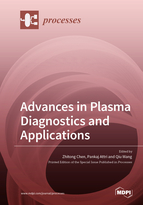Advances in Plasma Diagnostics and Applications
A special issue of Processes (ISSN 2227-9717). This special issue belongs to the section "Automation Control Systems".
Deadline for manuscript submissions: closed (15 January 2022) | Viewed by 27976
Special Issue Editors
2. Institute of Biomedical and Health Engineering, Shenzhen Institute of Advanced Technology, Chinese Academy of Sciences, Shenzhen 518055, China
Interests: plasma physics; plasma medicine; medical devices
Special Issues, Collections and Topics in MDPI journals
Interests: protein; plasma; chemistry; ESR
Special Issues, Collections and Topics in MDPI journals
Special Issue Information
Dear Colleagues,
Plasma is the fourth state of matter, contrasted with the other states: solid, liquid, and gas. Plasma can exist in a variety of forms due to discharge modes created in different ways, resulting in a wide range of applications. Plasma applications are interdisciplinary research fields that combine physics, chemistry, biology, and medicine. Plasma in contact with materials generates intense UV radiation, reactive species, electrons and charged particles, all of which are effective agents against many matters, and their processes are extremely complex. On the other hand, the plasma parameter space is very broad and ranges from the density of radicals to the velocity distribution of charged particles and even rovibrationally excited states or the population of excited electronic. The aim of this Special Issue is to collect original research and review articles on the most recent plasma applications and to diagnose their processes, to elucidate the characteristics of plasma and mechanisms of plasma-induced processes. Potential topics include, but are not limited to:
- Experimental measurement methods and diagnostic tools for detection of radicals in gas and liquid phase
- Modification in materials
- Materials processing (deposition, etching, washing, etc.)
- Industrial applications including water purification
- Biomedical/Agricultural/Food processing applications
Prof. Dr. Pankaj Attri
Dr. Zhitong Chen
Prof. Dr. Qiu Wang
Guest Editors
Manuscript Submission Information
Manuscripts should be submitted online at www.mdpi.com by registering and logging in to this website. Once you are registered, click here to go to the submission form. Manuscripts can be submitted until the deadline. All submissions that pass pre-check are peer-reviewed. Accepted papers will be published continuously in the journal (as soon as accepted) and will be listed together on the special issue website. Research articles, review articles as well as short communications are invited. For planned papers, a title and short abstract (about 100 words) can be sent to the Editorial Office for announcement on this website.
Submitted manuscripts should not have been published previously, nor be under consideration for publication elsewhere (except conference proceedings papers). All manuscripts are thoroughly refereed through a single-blind peer-review process. A guide for authors and other relevant information for submission of manuscripts is available on the Instructions for Authors page. Processes is an international peer-reviewed open access monthly journal published by MDPI.
Please visit the Instructions for Authors page before submitting a manuscript. The Article Processing Charge (APC) for publication in this open access journal is 2400 CHF (Swiss Francs). Submitted papers should be well formatted and use good English. Authors may use MDPI's English editing service prior to publication or during author revisions.
Keywords
- Plasma physics
- Plasma diagnostics
- Surface modification
- Plasma-assisted synthesis
- Plasma environment
- Plasma medicine
- Plasma agriculture








